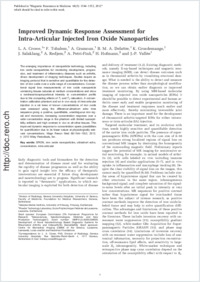Improved dynamic response assessment for intra-articular injected iron oxide nanoparticles
- Crowe, L. A. Division of Radiology, Geneva University Hospitals, University of Geneva, Faculty of Medicine, Foundation for Medical Researchers, Geneva, Switzerland
- Tobalem, F. Division of Radiology, Geneva University Hospitals, University of Geneva, Faculty of Medicine, Foundation for Medical Researchers, Geneva, Switzerland
- Gramoun, A. Division of Radiology, Geneva University Hospitals, University of Geneva, Faculty of Medicine, Foundation for Medical Researchers, Geneva, Switzerland
- Delattre, B. M. A. Division of Radiology, Geneva University Hospitals, University of Geneva, Faculty of Medicine, Foundation for Medical Researchers, Geneva, Switzerland
- Grosdemange, K. Division of Radiology, Geneva University Hospitals, University of Geneva, Faculty of Medicine, Foundation for Medical Researchers, Geneva, Switzerland
- Salaklang, Jatuporn Adolphe Merkle Institute, University of Fribourg, Fribourg, Switzerland
- Redjem, A. Adolphe Merkle Institute, University of Fribourg, Fribourg, Switzerland
- Petri-Fink, Alke Adolphe Merkle Institute, University of Fribourg, Fribourg, Switzerland
- Hofmann, Heinrich Powder Technology Laboratory, Ecole Polytechnique Fédérale de Lausanne, Lausanne, Switzerland
- Vallée, J.-P. Division of Radiology, Geneva University Hospitals, University of Geneva, Faculty of Medicine, Foundation for Medical Researchers, Geneva, Switzerland
-
31.01.2012
Published in:
- Magnetic Resonance in Medicine. - 2012, vol. 68, no. 5, p. 1544–1552
English
The emerging importance of nanoparticle technology, including iron oxide nanoparticles for monitoring development, progression, and treatment of inflammatory diseases such as arthritis, drives development of imaging techniques. Studies require an imaging protocol that is sensitive and quantifiable for the detection of iron oxide over a wide range of concentrations. Conventional signal loss measurements of iron oxide nanoparticle containing tissues saturate at medium concentrations and show a nonlinear/nonproportional intensity to concentration profile due to the competing effects of T1 and T2 relaxation. A concentration calibration phantom and an in vivo study of intra-articular injection in a rat knee of known concentrations of iron oxide were assessed using the difference-ultrashort echo time sequence giving a positive, quantifiable, unambiguous iron signal and monotonic, increasing concentration response over a wide concentration range in the phantom with limited susceptibility artifacts and high contrast in vivo to all other tissues. This improved dynamic response to concentration opens possibilities for quantification due to its linear nature at physiologically relevant concentrations.
- Faculty
- Faculté des sciences et de médecine
- Department
- Département de Chimie
- Language
-
- English
- Classification
- Chemistry
- License
- License undefined
- Identifiers
-
- RERO DOC 31155
- DOI 10.1002/mrm.24166
- Persistent URL
- https://folia.unifr.ch/unifr/documents/302820
Statistics
Document views: 92
File downloads:
- fin_idr.pdf: 175
